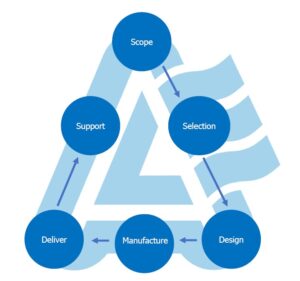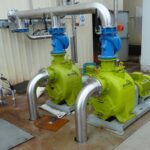This question often causes people to wonder. The short answer why your pump’s impeller has holes in it, or even vanes on the backside, is to reduce the axial thrust in the pump.
But further explained; a centrifugal pump that has been properly and affectively designed will manage the dynamic forces for a trouble-free pump operation. This will occur regardless of your pump’s size. Due to the efficient design, and the management of all these forces, ultimately the effects of these forces in play will be eliminated. Of all these forces the 2 main forces to consider are axial forces and radial forces.
Axial forces act on the rotor in a direction parallel to the centreline of the shaft.
On the other hand, radial forces work at a right angle to the centreline of the shaft.
Why do axial forces occur in the pump?
When there are variations in pressure between one side of the impeller and the other, axial forces arise. These are created due to the high pressure acting on one side. The main area where this forces acts is the impeller shroud, either located on one or both sides of the impeller vanes.
How are axial forces neutralised by impeller design?
The axial force can be counterpoised by using balance drums in large multistage pumps. Some multistage pumps also use opposite impellers to counteract the effect of axial forces. For example, in a six stage centrifugal pump, 3 impellers face in one direction, while the other 3 are positioned in the opposite direction.
Another instance of this occurring is when an impeller is used with two inlet eyes positioned at 180 degrees from each other. The two holes balance out the axial force and neutralise its impact.
In the pump market, 99% of end-suction pumps use semi-open impellers. This means they only have a shroud on one end of the impeller. Due to the design of these impellers, costs are reduced and they’re somewhat easy to manufacture. However, using impellers with shrouds produce one negative; that is there is a chance of higher unbalanced axial forces. When the pump is working under general operating conditions, the forces on the impeller’s back is much higher than the forces on the front. As a result, the forces try to push the impeller towards the suction end. Suction pumps can experience up to 385kg of pressure towards the suction end, due to the axial forces’ effect.
This impact of these forces can however be reduced by installing bigger thrust bearings. But again, there is a negative that comes with this. The bigger bearings require bigger shafts and housings, meaning the pump’s initial price and maintenance costs will be increased.
Why are there balance holes?
Due the axial forces and the issues that arise from these, balance holes in the impeller are used. By using the correct number of holes, the axial force can be cancelled out. As with the axial forces, this also produces a negative. However, this is minor compared with the ones mentioned above. The impeller holes minimally reduce the pump’s efficiency and power; so therefore it doesn’t matter in the long run.
The bottom line…
After hours of research by the engineering team, every part of your pump is thoroughly and carefully designed. Even something as small as holes on the impeller are analysed, because it is known these play a crucial role in ensuring your pump has an operational efficiency for years to come.



























































































